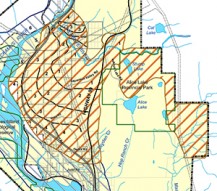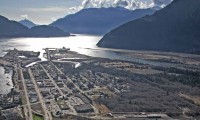Cheekeye Fan

Cheekeye Fan
The Cheekeye Fan is an alluvial fan, a formation found in mountainous regions where deposits of alluvial sedimentation and material from debris flows and debris floods accrue over time. Natural hazards common to this type of fan include stream floods, deposition of sediment, erosion of new channels, avulsions (a sudden shift in the channel of a stream or river) and debris floods and debris flows. The Cheekeye Fan is divided into 6 hazard zones with associated policy outlined in section 25 of the District of Squamish Official Community Plan. (View OCP Hazard Policies).
The Intergovernmental Cooperation Accord between the Squamish Nation and the District of Squamish included agreement that the Squamish Nation may apply, with or without a development partner, to the Province for ownership of approximately 200 acres of the Cheekeye Fan lands and for development approval of the land for single family residential housing and commercial development. As per OCP policy, any development will require hazard mitigation.
Cheekeye River Development
The proposed Cheekeye River Development would provide affordable and mixed-density housing for people living in Squamish. Located on both sides of Ross Road, between Highway 99 and Government Road, the proposed new neighbourhood is walking distance to Don Ross Secondary School and Brackendale Elementary School and existing Brackendale amenities. This project would provide 170 affordable and market rental units helping to achieve Housing Affordability and Diversity objectives in District of Squamish Strategic Plan. The project would also generate 71.5 acres of new public parks and gathering spaces, including the dedication of the 50-acre Brackendale Farmers’ Institute Park.
Since 2014, over 15 reports to Council have been received, and two public hearings have been held to provide an overview of the project and updates to the community.
The Cheekeye River Development is located on the Cheekeye Fan and is exposed to debris flow hazards. As a result, the District’s Official Community Plan requires that risk mitigation proposals for the Cheekeye Fan debris flow hazard area adequately address the associated risk and can be sustainability maintained. The Cheekeye River Development has proposed to build a large debris flow mitigation structure south of Cat Lake to mitigate risk to both existing and proposed development on the Cheekeye Fan.
On July 24, 2018, Council passed third readings of the Rezoning and OCP bylaws and established a series of conditions that must be met prior to adoption of the bylaws, primarily pertaining to Cheekeye Fan debris flow hazard and risk mitigation. This includes that the project proponent Sqomish Sea to Sky Developments LP must prepare a hazard assessment, debris flow modeling, risk assessment, detailed design of mitigation measures, operations and maintenance manual and cost estimate, and a funding model to operate and maintain the mitigation system in perpetuity.
Capital costs of the barrier will be paid by SSSD. It is proposed that the costs to maintain the barrier will be shared between a Local Area Service tax imposed on the proposed development and general taxation. It is estimated that the time to construct the barrier is two to three years plus a two-year warranty and maintenance period. Therefore, budget implications are a maximum of four to five years from the commencement of construction.
Proposed Bylaws:
- OCP Bylaw No. 2500, 2017, Amendment Bylaw (Cheekeye River Development) No. 2615, 2018
- Zoning Bylaw No. 2200, 2011 Amendment Bylaw (Cheekeye River Development CD-82), No. 2306, 2013
Timeline
- 2011 - Intergovernmental Cooperation Accord is signed.
- 2013 - Development Application received from Cornerstone Developments (now Sqomish Sea to Sky Developments LP – a partnership between Sḵwx̱wú7mesh Úxwumixw (Squamish Nation) and Matthews West).
- 2014/2015 – Expert Panels #1/#2 provide advice on Cheekeye Fan hazard magnitude and risk tolerance criteria
- 2015 - Council receives an introduction to Cheekeye Fan with an overview of development application and hazard mitigation approach.
- 2015 - Council gave the OCP amendment first reading with conditions related to debris flow risk mitigation, full scope of costs, establishment of risk tolerance criteria and public engagement.
- 2016 - First reading: Rezoning, Second reading: OCP amendment
- 2016 - Council passed a motion to have staff pursue the process with the developer to have the Upper Canyon Debris Barrier designed and reviewed.
- 2017 – Public Hearing #1
- 2018 – Public Hearing #2
- 2018 - Third readings of rezoning and OCP amendment. Council passed third readings with conditions.
- 2018 – present – Detailed design of Cheekeye barrier and permitting applications. Review by Independent Expert Review Panel.
- 2022 - District authorized Sqomish Sea to Sky Developments Ltd. (SSSD) to apply for Crown tenure for the Cheekeye Fan barrier in the District’s name to allow for construction and long term operations.
- 2024 – Council receives an update presentation.
June 11, 2024 – Public Hearing and Council Adoption of Rezoning and OCP Amendment Bylaws
July 15, 2024 – Post Adoption Council Endorsement Items
- This addressed items flagged at rezoning/OCP amendment adoption that had to be addressed before the developer could start construction of the barrier
- Report to Council and Council Meeting Minutes
The Detailed Design Report for the Cheekeye Barrier which includes the risk assessment, hazard mapping, and other pertinent background is here.
Resources and Reports
Cheekeye Fan Expert Panel Final Report (June 6, 2015)
Interim Development strategies on the Cheekeye Fan
Assessment of Mitigation Alternatives for Cheekeye Fan
Based on Expert Panel guidance that current risk on the Cheekeye Fan is unacceptable and that risk should be mitigated, the District undertook an assessment of mitigation options. Information and findings are contained in the following documents:
Background Reports
- KWL preliminary design report for Cheekeye Fan deflection berms (June 2003)
- Thurber & Golder Cheekeye River terrain hazard and land use study (Volume 1 March 1993)
- Thurber & Golder Cheekeye River terrain hazard and land use study (Volume 2 March 1993)
- BGC Cheekeye River Debris Flow Frequency and Magnitude (2008)
- BGC Debris Flow Risk (October 21, 2008)
- BGC Debris Flow Simulation (December 14, 2007)
Final Panel Report
Presentations to Council (July 15, 2014)
- Cheekeye River Fan Geohazards, risks and residential development
- Cheekeye Panel Report (John Clague, P. Geo)
- Staff report to Council
OCP Policy
- OCP Hazard Policies
- Flood and debris flow hazard areas map (see Schedule D-1).

